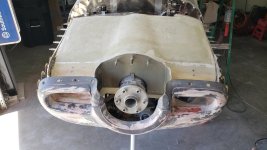TonyWilliams
Member
Is anybody using an enclosed pressure plenum above the air cooled engine cylinders so that the air pressure and velocity flowing past the cylinders is handled without “silicone baffles”?
Is anybody using an enclosed pressure plenum above the air cooled engine cylinders so that the air pressure and velocity flowing past the cylinders is handled without “silicone baffles”?

I can't help wondering if there isn't a middle ground between the standard baffle arrangement and the completely enclosed plenum? Presumably, the flaws of the standard baffle is the imperfect sealing of the silicone baffles "Flaps" against the top cowling. On the other hand, a plenum seals perfectly, but at the loss of access to the engine.
Suppose the top cowl had attached to it aluminum strips which would knife inside of the lower cowl baffles? Wouldn't the pressure inside the enclosed top area seal the top and bottom "Baffles" against each other? Yet, if the top cowl were removed, there would be no further layer to remove to gain access to the engine. Checking the oil wouldn't be harder, either.
This seems too obvious. Someone must have tried this and it failed, right?
I can't help wondering if there isn't a middle ground between the standard baffle arrangement and the completely enclosed plenum? Presumably, the flaws of the standard baffle is the imperfect sealing of the silicone baffles "Flaps" against the top cowling. On the other hand, a plenum seals perfectly, but at the loss of access to the engine.
Suppose the top cowl had attached to it aluminum strips which would knife inside of the lower cowl baffles? Wouldn't the pressure inside the enclosed top area seal the top and bottom "Baffles" against each other? Yet, if the top cowl were removed, there would be no further layer to remove to gain access to the engine. Checking the oil wouldn't be harder, either.
This seems too obvious. Someone must have tried this and it failed, right?
Am I correct in assuming that the sealing between the top cowling and the flexible parts of the baffle is the root of the inefficiency of standard baffling? Might the problem simply be the large volume of the space above an engine? Perhaps the intake air gets turbulent with all that space to play in? If that were the case, might it be possible to add a lowered "ceiling" above the engine which was part of the upper cowl to direct the cooling air? And, how is it that some oil dipsticks are accessible with plenums, and some are not?
